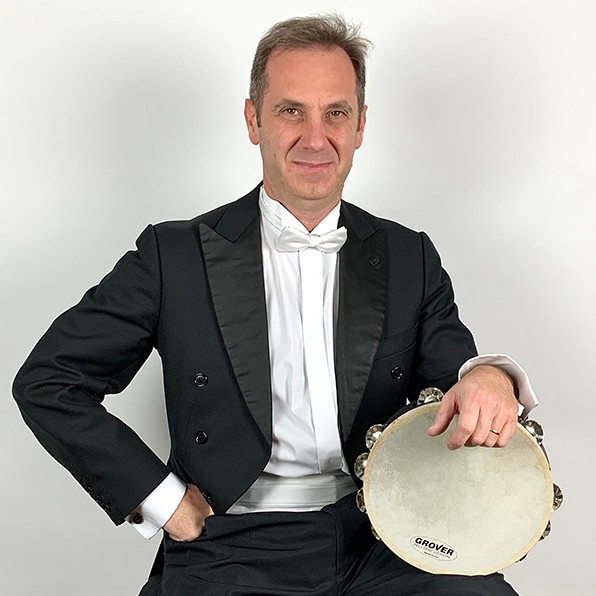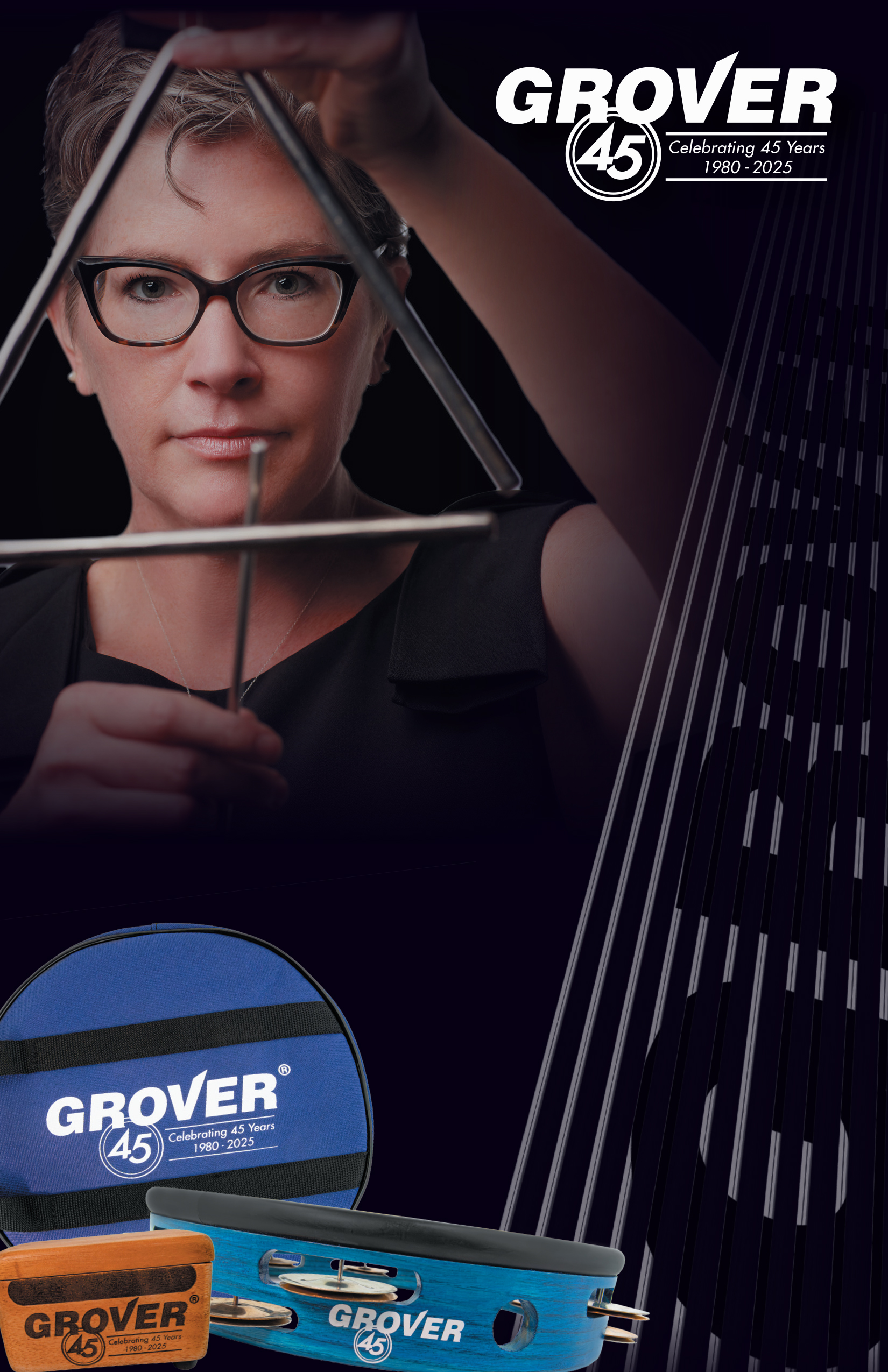We all know Prokofiev´s “Lieutenant Kijé” and its overly famous snare drum part, but the tambourine one in the fourth number, “Troika”, tends to go unnoticed.
Prokofiev wrote a circle above the first quarter-note of each bar:

This is the same notation that Glazunov had already used in “Rhapsodie Orientale” and in the “Polovtsian Dances” (please check this article: https://groverpro.com/prince-igors-tambourine-mystery-part-1). Prokofiev studied at the Saint Petersburg Conservatory, where Glazunov was a composition professor, and there was where he learned this technique and notation.
The A. Gutheil (S&N Koussevitzky) edition of “Lieutenant Kijé” gives these very clear instructions in the tambourine part:
Les notes munies du signe ‘o’ doivent ètre frappes. AIlleurs secouer l´instrument (“The notes with the symbol ‘o’ must be struck. Elsewhere shake the instrument”).
The preface to the Boosey & Hawkes score (HPS 663; B. & H. 16697) states the following in English, French and Russian:
In the part of the tambourine (No. 4) the sign ‘o’ above the note means a blow with the fist, while notes without ‘o’ mean shakes.
Dans la partie du tambour de basque (No. 4) le signe ‘o’ sur la note signifie un coup de poing, tandis qu´aux notes sans ‘o’ il faut secour.
Let´s now listen to how “Troika” sounds using the original technique indicated by Prokofiev.

David Valdés started playing piano at the age of seven. He discovered percussion at sixteen and studied both instrumental disciplines for several years but, once he gained his B.Mus. in Piano, percussion became his main interest.
He gained his B.Mus. in Percussion at the Oviedo Conservatory of Music under Rafael Casanova (OSPA), having obtained the “Angel Muñiz Toca” Extraordinary Award and the Principal’s Award. He also gained a B.Mus. in Solfege, Sight Reading and Transposition and has been trained in Chamber Music, Music Theory and Counterpoint.
David attended the Madrid based “Centro de Estudios Neopercusión”, where he studied with Juanjo Guillem (ONE), Enric Llopis (ORTVE), Francisco Díaz (OST), Juanjo Rubio (OCM), Oscar Benet (OCM), Belen López, David Mayoral and Serguei Sapricheff.
He studied at The Royal Academy of Music in London with Andrew Barclay (LPO), Simon Carrington (LPO), Leigh Howard Stevens, Nicholas Cole (RPO), Dave Hassell, Paul Clarvis, Neil Percy (LSO) and Kurt Hans Goedicke (LSO), where he gained his Postgraduate Diploma in Performance (Timpani and Percussion) and his LRAM. He also studied Jazz with Trevor Tompkins, Orchestral Conducting with Denise Ham and Choral Conducting with Patrick Russill.
David has attended many courses and master classes by renowned musicians: Jeff Prentice, Rainer Seegers, Benoit Cambrelaing, David Searcy, Ben Hoffnung, Philippe Spiecer, Enmanuel Sejourné, Keiko Abe, Eric Sammut, She-e Wu, Joe Locke, Anthony Kerr, Dave Jackson, Makoto Aruga, Chris Lamb, Collin Curie, Evelyn Glennie, Mircea Anderleanu, Steven Shick, John Bergamo, Airto Moreira, Birger Sulsbruck, Peter Erskine, Dave Weckl, Bill Cobham, Carlos Carli, George Hurst, Arturo Tamayo, Collin Meters, José María Benavente, Román Alís, Fernando Puchol, Michel Martín, Javier Cámara, Francisco José Cuadrado… These musicians have trained him in Percussion, Piano, Contemporary and Modal Harmony, Jazz, Conducting, Music Production, Editing and Microphone Techniques.
He was awarded the Principality of Asturias Government Scholarship three times in a row, he was finalist at the International Keyboard Percussion Competition sponsored by the Yamaha Foundation of Europe and was runner-up for the Deutsche Bank Pyramid Awards, given to innovative performance and composition projects.
David has played with the following orchestras: Gijón Symphony Orchestra (Spain), Principality of Asturias Symphony Orchestra (Spain), Oviedo Filarmonía (Spain), Asturias Classical Orchestra (Spain), Spanish National Orchestra (Spain), Catalonian Chamber Orchestra (Spain), Castilla y León Symphony Orchestra (Spain), Orchestra of the University of Oviedo (Spain), City of Avilés Symphony Orchestra (Spain), Moscow Virtuosi (Russia), Concerto München Sinfonieorchester (Germany), WDR Rundfunkorchester Köln (Germany), Arthur Rubinstein Philharmonic Orchestra (Poland), Orquestra do Norte (Portugal) and the Ulster Orchestra (UK). He has also played with early music ensembles (Forma Antiqva, Memoria de los Sentidos, Sphera Antiqva and Ensemble Matheus), and chamber groups (RAM Percussion Group, Neopercusión and Ars Mundi Ensemble).
He has translated into Spanish “Method of Movement for Marimba” (L. H. Stevens), the internationally acclaimed book used in conservatoires and universities worldwide. He is, also, the Spanish translator of www.percorch.com, the website used by many orchestras to organize their percussion sections. He is currently working on a new critical edition of the percussion part of “Histoire du Soldat” and on 19th century repertoire for fortepiano and tambourine.
He has taught at the Gijón and Oviedo Conservatories of Music. His discography includes many different genres, and he has worked as a session musician, arranger and online instrumentalist as the result of his interest in recording, sound and technology. David is a busy timpani/percussion freelancer and runs his own business: “Producciones Kapellmaister”.

Leave a Reply